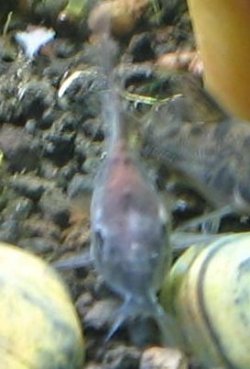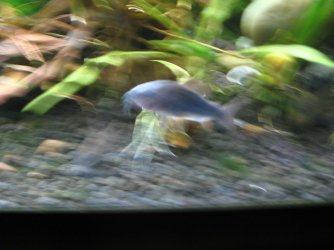Just setting up a 20-gallon long, heavily planted tank (details at the bottom of the post).
Lightly loaded, and all but one of the 5 small fish seem to be doing just fine. Just one cory cat, of a pair, has a white, slightly spotty coating on his front half, more or less, that improves, then gets worse again. at times, it seems to be shedding a little bit of the coating in small areas. The coating is often hardly noticeable if light hits it from a steep angle, but it looks really bright white if light hits it at a glancing angle. The fish eats OK, but seems a little jumpy, and does scrape against things, similar to what a fish might do with a disease or water quality issue. This fish had a damaged dorsal spine, and a little fin rot, which seems healed, and the problem arose about the time the rot healed.
SEE PHOTOS
I am using API Melafix, but this is just a healing aid, not a cure for anything, it does seem to be helping after 2 days, in the sense that the cory seems less jumpy, and the coating looks a LITTLE better, but that has happened before.
My question is; Does this seem to be fungal or bacterial?
What medication is recommended?
-------------------------------------------------------------------------------------------------------------------------------------
Doing a 25% water change, once a week, using de-chlor hard tap water, to keep GH up.
2 large sponge filters and a separate ceramic air diffuser, all on 2 Tetra 20-50 gallon air pumps. (plan to add another power filter after the sponges are well-cycled & fish load is increased.
Temp is held near 78F by a heater.
Setting up the clean-up crew and cycling, so at the moment only stocked with
LOTS of live plants in eco-complete black substrate.
A colony of several hundred Malaysian trumpet snails
1 large rabbit snail
1 very large Nerite snail
2 rainbow sharks
1 small/medium pleco.
2 cory cats.
Feeding Tetra Pro Pleco Wafers, and Omega One Super Carnivore (frozen blood worms, brine & mysis shrimp) .
Lightly loaded, and all but one of the 5 small fish seem to be doing just fine. Just one cory cat, of a pair, has a white, slightly spotty coating on his front half, more or less, that improves, then gets worse again. at times, it seems to be shedding a little bit of the coating in small areas. The coating is often hardly noticeable if light hits it from a steep angle, but it looks really bright white if light hits it at a glancing angle. The fish eats OK, but seems a little jumpy, and does scrape against things, similar to what a fish might do with a disease or water quality issue. This fish had a damaged dorsal spine, and a little fin rot, which seems healed, and the problem arose about the time the rot healed.
SEE PHOTOS
I am using API Melafix, but this is just a healing aid, not a cure for anything, it does seem to be helping after 2 days, in the sense that the cory seems less jumpy, and the coating looks a LITTLE better, but that has happened before.
My question is; Does this seem to be fungal or bacterial?
What medication is recommended?
-------------------------------------------------------------------------------------------------------------------------------------
Doing a 25% water change, once a week, using de-chlor hard tap water, to keep GH up.
2 large sponge filters and a separate ceramic air diffuser, all on 2 Tetra 20-50 gallon air pumps. (plan to add another power filter after the sponges are well-cycled & fish load is increased.
Temp is held near 78F by a heater.
Setting up the clean-up crew and cycling, so at the moment only stocked with
LOTS of live plants in eco-complete black substrate.
A colony of several hundred Malaysian trumpet snails
1 large rabbit snail
1 very large Nerite snail
2 rainbow sharks
1 small/medium pleco.
2 cory cats.
Feeding Tetra Pro Pleco Wafers, and Omega One Super Carnivore (frozen blood worms, brine & mysis shrimp) .





